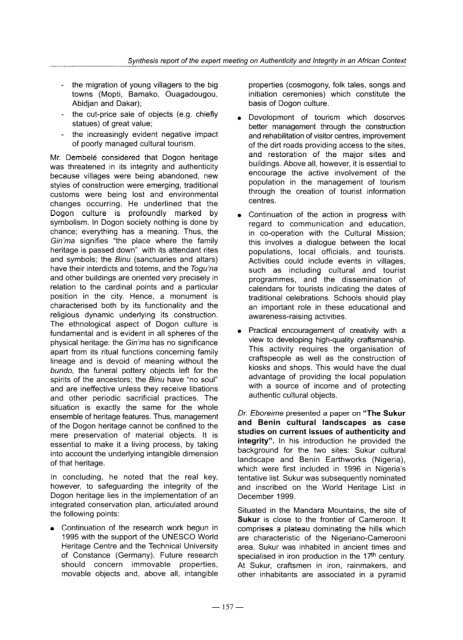Mul - unesdoc - Unesco
Mul - unesdoc - Unesco
Mul - unesdoc - Unesco
You also want an ePaper? Increase the reach of your titles
YUMPU automatically turns print PDFs into web optimized ePapers that Google loves.
Synthesis report of the expert meeting on Authenticity and Integrity in an African Context<br />
- the migration of Young villagers to the big<br />
towns (Mopti, Bamako, Ouagadougou,<br />
Abidjan and Dakar);<br />
- the tut-price sale of abjects (e.g. chiefly<br />
statues) of great value;<br />
- the increasingly evident negative impact<br />
of poorly managed cultural tourism.<br />
Mr. Dembelé considered that Dogon heritage<br />
was threatened in its integrity and authenticity<br />
because villages were being abandoned, new<br />
styles of construction were emerging, traditional<br />
customs were being lost and environmental<br />
changes occurring. He underlined that the<br />
Dogon culture is profoundly marked by<br />
symbolism. In Dogon society nothing is done by<br />
chance; everything has a meaning. Thus, the<br />
Gin’ma signifies “the place where the family<br />
heritage is passed down” with its attendant rites<br />
and symbols; the Binu (sanctuaries and altars)<br />
have their interdicts and totems, and the Togu’na<br />
and other buildings are oriented very precisely in<br />
relation to the cardinal points and a particular<br />
position in the City. Hence, a monument is<br />
characterised both by its functionality and the<br />
religious dynamic underlying its construction.<br />
The ethnological aspect of Dogon culture is<br />
fundamental and is evident in all spheres of the<br />
physical heritage: the Gin’ma has no significance<br />
apart from its ritual functions concerning family<br />
lineage and is devoid of meaning without the<br />
bundo, the funeral pottery abjects left for the<br />
spirits of the ancestors; the f3inu have “no SOU~”<br />
and are ineffective unless they receive libations<br />
and other periodic sacrificial practices. The<br />
situation is exactly the same for the whole<br />
ensemble of heritage features. Thus, management<br />
of the Dogon heritage cannot be confined to the<br />
mere preservation of material abjects. It is<br />
essential to make it a living process, by taking<br />
into account the underlying intangible dimension<br />
of that heritage.<br />
In concluding, he noted that the real key,<br />
however, to safeguarding the integrity of the<br />
Dogon heritage lies in the implementation of an<br />
integrated conservation plan, articulated around<br />
the following points:<br />
l Continuation of the research work begun in<br />
1995 with the support of the UNESCO World<br />
Heritage Centre and the Technical University<br />
of Constance (Germany). Future research<br />
should concern immovable properties,<br />
movable abjects and, above all, intangible<br />
- 157-<br />
properties (cosmogony, folk tales, songs and<br />
initiation ceremonies) which constitute the<br />
basis of Dogon culture.<br />
Development of tourism which deserves<br />
better management through the construction<br />
and rehabilitation of visitor centres, improvement<br />
of the dirt roads providing access to the sites,<br />
and restoration of the major sites and<br />
buildings. Above all, however, it is essential to<br />
encourage the active involvement of the<br />
population in the management of tourism<br />
through the creation of tourist information<br />
centres.<br />
Continuation of the action in progress with<br />
regard to communication and education,<br />
in co-operation with the Cultural Mission;<br />
this involves a dialogue between the local<br />
populations, local officiais, and tourists.<br />
Activities could include events in villages,<br />
such as including cultural and tourist<br />
programmes, and the dissemination of<br />
calendars for tourists indicating the dates of<br />
traditional celebrations. Schools should play<br />
an important role in these educational and<br />
awareness-raising activities.<br />
Practical encouragement of creativity with a<br />
view to developing high-quality craftsmanship.<br />
This activity requires the organisation of<br />
craftspeople as well as the construction of<br />
kiosks and shops. This would have the dual<br />
advantage of providing the local population<br />
with a source of income and of protecting<br />
authentic cultural abjects.<br />
Dr. Eboreime presented a paper on “The Sukur<br />
and Benin cultural landscapes as case<br />
studies on current issues of authenticity and<br />
integrity”. In his introduction he provided the<br />
background for the two sites: Sukur cultural<br />
landscape and Benin Earthworks (Nigeria),<br />
which were first included in 1996 in Nigeria’s<br />
tentative list. Sukur was subsequently nominated<br />
and inscribed on the World Heritage List in<br />
December 1999.<br />
Situated in the Mandara Mountains, the site of<br />
Sukur is close to the frontier of Cameroon. It<br />
comprises a plateau dominating the hills which<br />
are characteristic of the Nigeriano-Camerooni<br />
area. Sukur was inhabited in ancient times and<br />
specialised in iron production in the 17th Century.<br />
At Sukur, craftsmen in iron, rainmakers, and<br />
other inhabitants are associated in a pyramid

















